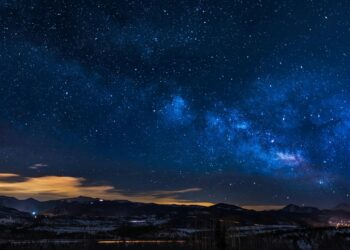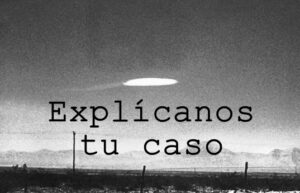Beatriz Villarroel holds a PhD in Astronomy from Uppsala University in Sweden and works as an Assistant Professor at the Nordic Institute for Theoretical Physics in Stockholm. She completed her international postdoctoral fellowship jointly between NORDITA and the Institute of Astrophysics of the Canary Islands, and is of Swedish nationality, although she has Spanish ancestry, as one of her grandparents was one of the children who were relocated to the Soviet Union during the Civil War.

Throughout her career she has received several awards for her work, such as the L’Oréal-UNESCO For Women in Science award, received in 2022, in the category of International Rising Talents, and has published articles in prestigious scientific journals such as the Astronomical Journal, Astrophysical Journal, Nature Physics, and Monthly Notices of the Royal Astronomical Society. She has also participated as a speaker at one of the popular TEDx Talks, where she captivated the audience with her wit and intelligence through her presentation «Why We Should Search for Alien Artifacts». In UAP DIGITAL, we reproduce the article that she recently published in The Conversation about her research.

She has recently been appointed as a member of the Advisory Board of the SOL Foundation, a newly established institute aiming to become a top-tier center for UAP research, with the goal of conducting academic, well-funded and cutting-edge research on the phenomenon and its broad implications. In her inaugural lecture, which took place last November at Stanford University, she delivered a talk on two projects she leads, VASCO and EXOPROBE, which have brought her recognition and represent the implementation of new and imaginative approaches to the study of the phenomenon.
VASCO and EXOPROBE, Two Exciting Projects
- VASCO, Vanishing & Appearing Sources during a Century of Observations, is a project dedicated to the search for celestial objects that appeared and disappeared over the span of 70 years. While the original objective was to search for a star that had disappeared, the possibility arose of finding objects that completely disappeared without leaving a trace and could be the signature of an advanced civilization. Archival images dating back to the early 1950s, captured at the Palomar Observatory in California, are used for the search. The advantage of working with images from that era is that there were no human-made objects in the sky at that time. During their survey, they have found multiple examples of «transients» that appeared and disappeared, and whose explanation could be that they were artificial objects at a time when there should not have been any in space. Interestingly, two of the most relevant examples occurred on dates coinciding with the great UFO wave in Washington, in 1952, on July 19 and 27. The Debrief website recently published an excellent article by Beatriz Villarroel, in which she explains the project in detail, the possible explanations for the anomalies found and the difficulty in publishing scientific articles on their results, as well as revealing the involvement of the skeptic Donald Menzel as responsible for the inexplicable destruction of a significant part of the Harvard University observatory’s photographic plates collection.


- EXOPROBE is a recent project that began in August 2023, and represents a new era in Optical SETI. Its purpose is to detect, locate, and verify potential non-human artificial objects by searching for a specific and identifiable signature of such objects, produced by a quick flash of light. Its search range will be outside the Earth’s atmosphere, between 35,700 km and 150 million kilometers from Earth, and will consist of a global network of wide-field telescopes with high-speed cameras that provide temporal resolution, spatial resolution, and spectral resolution of any discovery. UAPs would be identified and verified in real-time, and Dr. Villarroel has stated her intention to develop methods to capture and bring to Earth any extraterrestrial probes that are located.

The Importance of an Independent and non-stigmatizing science in UAP Research
Projects such as those led by Villarroel are crucial for the study of the phenomenon as they emerge from entities not affiliated with the military and intelligence world, which have always been associated with disinformation and secrecy, and are highly focused on aspects related to National Security. This need for independence becomes evident at a time when the «official route,» which seeks access to information that has been collected by various branches of the United States Government for decades, seems to be stuck after the cuts to the transparency intended by the so-called Schumer proposal, the Pentagon’s reluctance to share information with members of Congress, and the disappointment represented by AARO, the UAP research office created by the Department of Defense.
The fact that prestigious scientists such as Garry Nolan, Avi Loeb, or Villarroel are coming forward and getting involved in the study of a mystery that has not been scientifically addressed because it was considered taboo is significant and indicative of a gradual reduction of the stigma. In an interesting interview on Tim Ventura’s podcast, doctor Villarroel referred to the issue as follows:
«Thanks to the de-stigmatization of UAPs we have opened up a completely new parameter’s space for a search close to Earth, and even within the atmosphere. And we know it’s reasonable that someone could send something close to Earth. So… why haven’t we been able to look for it before? The stigma has really disrupted much of the scientific possibilities, and the stigma is disappearing. I think it’s fantastic, it opens a new door to the search for extraterrestrial intelligence.»
In certain sectors of astronomy, there has historically been reluctance, if not hostility, to consider the possibility that other civilizations may be visiting us. Particularly striking is the case of the SETI Institute, which for decades has been unsuccessfully searching for radio signals. They have always maintained that the chances of the existence of intelligent life are very high, but their «senior astronomer,» Seth Shostak, has been ridiculing the UFO phenomenon for many years, although recently he supports its investigation. Among the arguments put forward by so-called skeptics, the difficulty of traversing the enormous distances in the universe with known physics is in a preeminent place. However, following the revelations of recent years, with the publication of the existence of official programs dedicated to the study of the phenomenon, the interest of Congress, and the creation of the NASA panel of scientists, it seems that it is beginning to be normal for the scientific community to stop considering the existence of other intelligences as something possible to be found only in the unfathomable depths of space, and to start directing the search to our own backyard, the solar system. This is what Villarroel and her team have done.
A Scientist with Courage and New Ideas
From within the astronomical community itself, Beatriz Villarroel was cancelled for collaborating in her VASCO project with Geoff Marcy, a pioneer in the search for exoplanets, who was involved in a case of inappropriate conduct for which he was never judged, preventing her from presenting the results of her research at a SETI conference, as well as taking other reprisals against her.
The story, told by herself in her article «A testimony of harassment by ‘guilt by association’ in astronomy,» is an example of how the human condition and its miseries contaminate everything, including the field of supposed absolute objectivity, science.
The courage she demonstrated in defending what she believes in was recognized at the 2023 Open Inquiry Awards, presented by the Heterodox Academy, highlighting her bravery: «Defending one’s freedom to conduct research with a distinguished scholar in the face of widespread rejection at such an early stage of one’s career is impressive.»
We are looking at a young and brilliant individual, with a career ahead of her, who has been able to break through with new ideas in the field of astronomy and the attempts to find intelligent life, without fear of the scientific establishment or stigma. Her enthusiasm and intelligence are evident in the multiple podcasts and interviews available online, and there is no doubt that her example will serve as inspiration to others. We need more like her.
|











